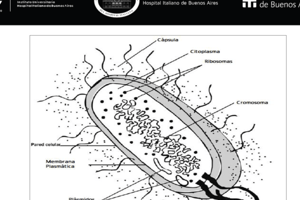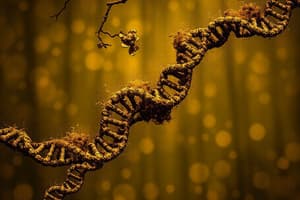Podcast
Questions and Answers
What two components form the backbone of a polynucleotide chain?
What two components form the backbone of a polynucleotide chain?
- Thymine and Guanine
- Adenine and Cytosine
- Sugar and Protein
- Sugar and Phosphates (correct)
Uracil is found in RNA instead of thymine.
Uracil is found in RNA instead of thymine.
True (A)
Who proposed the Double Helix model of DNA?
Who proposed the Double Helix model of DNA?
James Watson and Francis Crick
DNA was first identified by _____ in 1869.
DNA was first identified by _____ in 1869.
What type of bond pairs the bases in the two strands of DNA?
What type of bond pairs the bases in the two strands of DNA?
Match the nitrogenous bases with their pair:
Match the nitrogenous bases with their pair:
The two strands of DNA have the same polarity.
The two strands of DNA have the same polarity.
Adenine forms _____ hydrogen bonds with Thymine.
Adenine forms _____ hydrogen bonds with Thymine.
What is the role of the promoter in a transcription unit?
What is the role of the promoter in a transcription unit?
The template strand of DNA has the same sequence as the RNA transcribed from it, except for the presence of uracil instead of thymine.
The template strand of DNA has the same sequence as the RNA transcribed from it, except for the presence of uracil instead of thymine.
What strand acts as the template for RNA synthesis during transcription?
What strand acts as the template for RNA synthesis during transcription?
The __________ is located towards the downstream end of the coding strand and defines the end of transcription.
The __________ is located towards the downstream end of the coding strand and defines the end of transcription.
What is the primary role of the enzyme beta-galactosidase in the lac operon?
What is the primary role of the enzyme beta-galactosidase in the lac operon?
Match the components of a transcription unit with their descriptions:
Match the components of a transcription unit with their descriptions:
Which of the following correctly describes the coding strand?
Which of the following correctly describes the coding strand?
The lac operon contains two structural genes and one regulatory gene.
The lac operon contains two structural genes and one regulatory gene.
If the positions of the promoter and terminator are switched, the identities of the coding and template strands are also reversed.
If the positions of the promoter and terminator are switched, the identities of the coding and template strands are also reversed.
Who were the first to elucidate the transcriptionally regulated system of the lac operon?
Who were the first to elucidate the transcriptionally regulated system of the lac operon?
In the lac operon, the gene labeled 'i' is responsible for coding the ________ of the operon.
In the lac operon, the gene labeled 'i' is responsible for coding the ________ of the operon.
Describe the direction of transcription during RNA synthesis.
Describe the direction of transcription during RNA synthesis.
Match the following components of the lac operon with their functions:
Match the following components of the lac operon with their functions:
What regulates the expression of the genes in the lac operon?
What regulates the expression of the genes in the lac operon?
The operator region in prokaryotic DNA facilitates the binding of activating proteins to the promoter.
The operator region in prokaryotic DNA facilitates the binding of activating proteins to the promoter.
Name a few examples of operons other than the lac operon.
Name a few examples of operons other than the lac operon.
What is the estimated total number of genes in the human genome?
What is the estimated total number of genes in the human genome?
The Y chromosome contains the most genes among all human chromosomes.
The Y chromosome contains the most genes among all human chromosomes.
What percentage of nucleotide bases are exactly the same in all people?
What percentage of nucleotide bases are exactly the same in all people?
The human genome contains approximately ______ million base pairs.
The human genome contains approximately ______ million base pairs.
Match the following chromosomes with the number of genes they contain:
Match the following chromosomes with the number of genes they contain:
What is the largest known human gene?
What is the largest known human gene?
Less than 2 percent of the human genome codes for proteins.
Less than 2 percent of the human genome codes for proteins.
What do SNPs stand for in the context of genetics?
What do SNPs stand for in the context of genetics?
What is one of the primary uses of understanding DNA variations among individuals?
What is one of the primary uses of understanding DNA variations among individuals?
Bacteria and yeast are commonly used as hosts in DNA cloning.
Bacteria and yeast are commonly used as hosts in DNA cloning.
What does EST stand for in the context of gene expression?
What does EST stand for in the context of gene expression?
The method of sequencing developed by Frederick Sanger is primarily used for determining the sequence of _____ in proteins.
The method of sequencing developed by Frederick Sanger is primarily used for determining the sequence of _____ in proteins.
Match the following non-human organisms with their common applications:
Match the following non-human organisms with their common applications:
What is the term used to refer to the assignment of functions to different regions in a DNA sequence?
What is the term used to refer to the assignment of functions to different regions in a DNA sequence?
DNA can be sequenced in very long pieces without technical limitations.
DNA can be sequenced in very long pieces without technical limitations.
What are the names of the vectors used for bacterial and yeast cloning?
What are the names of the vectors used for bacterial and yeast cloning?
What was concluded from the transformation of R strain bacteria by heat-killed S strain bacteria?
What was concluded from the transformation of R strain bacteria by heat-killed S strain bacteria?
The genetic material was already established as DNA before the experiments of Avery, MacLeod, and McCarty.
The genetic material was already established as DNA before the experiments of Avery, MacLeod, and McCarty.
What did Hershey and Chase use to differentiate between protein and DNA in their experiments?
What did Hershey and Chase use to differentiate between protein and DNA in their experiments?
The biochemical characterization of the transforming principle led to the conclusion that ______ is the hereditary material.
The biochemical characterization of the transforming principle led to the conclusion that ______ is the hereditary material.
Match the scientists with their contributions to the understanding of genetic material:
Match the scientists with their contributions to the understanding of genetic material:
What was the result of digesting the transforming substance with DNase?
What was the result of digesting the transforming substance with DNase?
Proteins and RNA did not affect the transformation of R cells into S cells.
Proteins and RNA did not affect the transformation of R cells into S cells.
What type of viruses did Hershey and Chase study in their experiments?
What type of viruses did Hershey and Chase study in their experiments?
Flashcards
Transcription Unit
Transcription Unit
A DNA sequence that defines a region where a gene is transcribed into RNA.
Promoter
Promoter
The sequence within a transcription unit that signals the initiation of transcription.
Structural Gene
Structural Gene
The DNA sequence within a transcription unit that codes for the RNA molecule.
Terminator
Terminator
Signup and view all the flashcards
Coding Strand
Coding Strand
Signup and view all the flashcards
Template Strand
Template Strand
Signup and view all the flashcards
Direction of RNA Polymerase
Direction of RNA Polymerase
Signup and view all the flashcards
Upstream
Upstream
Signup and view all the flashcards
Transformation in bacteria
Transformation in bacteria
Signup and view all the flashcards
Transforming principle
Transforming principle
Signup and view all the flashcards
Protease
Protease
Signup and view all the flashcards
RNase
RNase
Signup and view all the flashcards
DNase
DNase
Signup and view all the flashcards
Bacteriophage
Bacteriophage
Signup and view all the flashcards
Bacteriophage infection
Bacteriophage infection
Signup and view all the flashcards
Hershey-Chase Experiment
Hershey-Chase Experiment
Signup and view all the flashcards
Genome sequencing
Genome sequencing
Signup and view all the flashcards
Expressed Sequence Tags (ESTs)
Expressed Sequence Tags (ESTs)
Signup and view all the flashcards
Bacterial Artificial Chromosomes (BACs) and Yeast Artificial Chromosomes (YACs)
Bacterial Artificial Chromosomes (BACs) and Yeast Artificial Chromosomes (YACs)
Signup and view all the flashcards
Sequence Annotation
Sequence Annotation
Signup and view all the flashcards
Automated DNA Sequencers
Automated DNA Sequencers
Signup and view all the flashcards
Sanger Sequencing
Sanger Sequencing
Signup and view all the flashcards
Sequence Assembly
Sequence Assembly
Signup and view all the flashcards
Sequence Alignment Programs
Sequence Alignment Programs
Signup and view all the flashcards
DNA Backbone
DNA Backbone
Signup and view all the flashcards
Nitrogenous Bases
Nitrogenous Bases
Signup and view all the flashcards
Complementarity
Complementarity
Signup and view all the flashcards
Antiparallel
Antiparallel
Signup and view all the flashcards
Base Pairing
Base Pairing
Signup and view all the flashcards
DNA Replication
DNA Replication
Signup and view all the flashcards
Double Helix Model
Double Helix Model
Signup and view all the flashcards
Prokaryotic Gene Regulation
Prokaryotic Gene Regulation
Signup and view all the flashcards
Operator Proteins
Operator Proteins
Signup and view all the flashcards
Operator
Operator
Signup and view all the flashcards
Operon
Operon
Signup and view all the flashcards
Repressor Gene
Repressor Gene
Signup and view all the flashcards
Activator
Activator
Signup and view all the flashcards
Lac Operon
Lac Operon
Signup and view all the flashcards
Human Genome
Human Genome
Signup and view all the flashcards
SNPs (Single Nucleotide Polymorphisms)
SNPs (Single Nucleotide Polymorphisms)
Signup and view all the flashcards
Repetitive Sequences
Repetitive Sequences
Signup and view all the flashcards
Microsatellites
Microsatellites
Signup and view all the flashcards
DNA Fingerprinting
DNA Fingerprinting
Signup and view all the flashcards
Chromosome Sequencing
Chromosome Sequencing
Signup and view all the flashcards
Gene Count Surprise
Gene Count Surprise
Signup and view all the flashcards
Study Notes
Molecular Basis of Inheritance
- DNA is the genetic material for most organisms
- DNA replicates semiconservatively
- DNA is a double helix with two anti-parallel strands
- Base pairing: Adenine (A) with Thymine (T), Guanine (G) with Cytosine (C)
- Nucleotides are the building blocks of nucleic acids
- DNA replication involves unwinding the helix, separating strands, and synthesizing new complementary strands
- The process of copying genetic information from one strand of DNA into RNA is called transcription
- RNA polymerase is the enzyme that catalyzes transcription
- The genetic code specifies the sequence of amino acids in proteins
- Translation is the process of protein synthesis, where mRNA is read by ribosomes to create proteins using tRNA
- Regulation of gene expression controls when and where genes are expressed
- Operons are groups of genes that are regulated together in prokaryotes
- DNA fingerprinting identifies differences in DNA sequences using repetitive DNA sequences
- Mutations can cause changes in the sequence of DNA, leading to variations in traits
Studying That Suits You
Use AI to generate personalized quizzes and flashcards to suit your learning preferences.





